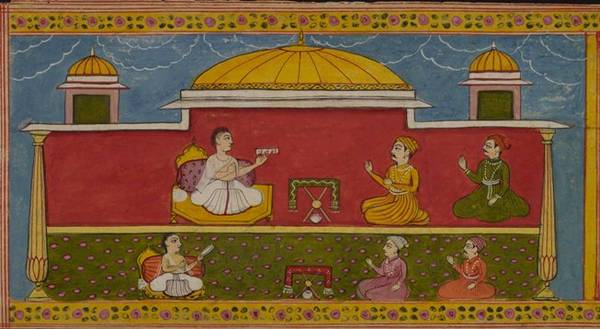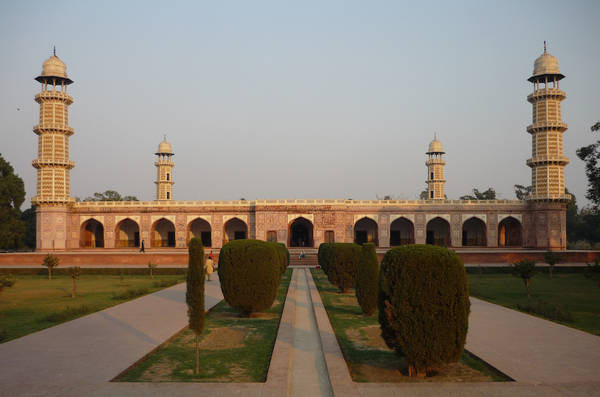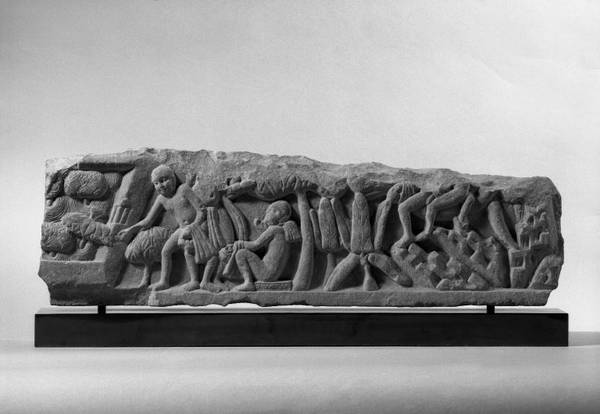Article: Jains and the Mughals
Jain relations with the Mughals began under the third emperor, Akbar. Jains from multiple Śvetāmbara sects, especially the Tapā-gaccha and Kharatara-gaccha, visited the royal court for a variety of reasons. Jain leaders often gained political concessions from the imperial elite that advanced their religious and community interests. Some monks also participated in the cultural life of Akbar’s court, such as taking part in religious debates.
During the reign of Akbar’s successor, Jahangir, relations between Jains and the Mughal court became rocky and ceased altogether by the 1620s. Nonetheless, outside imperial circles, contacts between Jains and Muslims remained generally affable, and commercial dealings prospered. Persian influences from Mughal painting can also be detected in Jain art of this period, especially that produced in Gujarat.
Digambara Jains do not appear to have visited the imperial court or to have had direct contact with the Mughal elite. But Digambara thinkers were highly aware of the Mughals and responded to their growing imperial power in both material and literary ways.
Akbar and the Jains
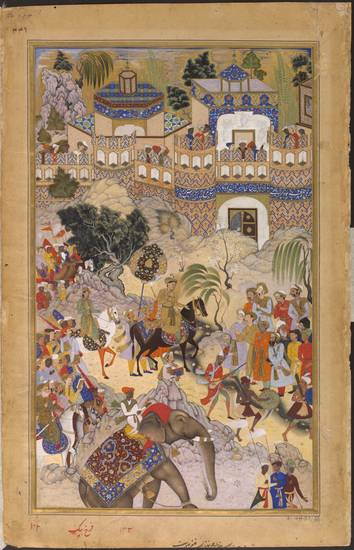
Akbar enters Surat
Image by Victoria and Albert Museum, London © Victoria and Albert Museum, London
The Mughal Emperor Akbar met members of three Śvetāmbara communities. The resulting encounters were highly varied and include:
- political negotiations
- religious debates
- the bestowal of titles
- the production of Sanskrit texts for the Mughals.
Modern historians have still not taken due notice of the diverse roles that Jains played at the Mughal court.
In the 1560s, Padmasundara of the Nāgapurīya Tapā-gaccha sect was the first Jain to visit the imperial court, then at Agra, in modern Uttar Pradesh. While there he crafted a treatise on Sanskrit aesthetic theory at the emperor’s request, titled Akbara-sāhi-śṛṅgāra-darpaṇa – Mirror of the Erotic for Emperor Akbar. There is little additional information regarding Padmasundara’s time at court, except that he left behind a small library upon his death. Akbar later gave the books to Hīravijaya-sūri of the Tapā-gaccha. After Padmasundara, no more Nāgapurīya mendicants appear to have pursued relations with the Mughals.
Following Gujarat‘s absorption into the Mughal Empire in the 1570s, Śvetāmbara Jains in the region built up cordial relations with the ruling power. The Tapā-gaccha and Kharatara-gaccha both developed significant imperial connections during the 1580s to 1610s. Though they often performed similar functions or even worked together at court, the sects also competed for Mughal edicts granting control over Shatrunjaya, a contested pilgrimage site in Gujarat.
Jains generally celebrated their leaders’ close imperial ties and associated influence on Mughal rulers. Even so, there was some disquiet at the notion of Jain mendicants, who renounce worldly matters for spiritual progress, attending the court of an earthly king.
Akbar and his son Jahangir bestowed Sanskrit and Persian titles on members of both monastic lineages as marks of favour. Akbar also interfered with the ascetic ranks of both the Tapā-gaccha and Kharatara-gaccha. He promoted ascetics to new positions – signified by titles, such as sūri – on several occasions. Members of the Jain community accepted the emperor’s active role, but they often insisted on having the current head of their sect perform the rituals necessary to fomally recognise the change in status.
Tapā-gaccha contacts
Members of the Tapā-gaccha cultivated extensive connections with the Mughal elite. After Hīravijaya-sūri established relations in 1582, Tapā-gaccha monks were continuously present at the imperial court for 30-odd years. They asked for numerous political concessions from the Mughals and also participated in court life. Tapā-gaccha writers generally lauded these fruitful ties but also sometimes felt uncomfortable with the idea of ascetic monks attending a worldly court.
Hīravijaya-sūri, the leader of the Tapā-gaccha, first met Emperor Akbar in Fatehpur Sikri, Uttar Pradesh, in 1582. According to Sanskrit and Gujarati hagiographies, Akbar summoned Hīravijaya from Gujarat after hearing about the monk’s legendary wisdom and religious devotion. The Mughal takeover of Gujarat in 1572 to 1573 also provided political incentives for Jains from the region to build imperial relations. Hīravijaya travelled on foot to meet the Mughal king and remained at court for a few years along with several of his disciples.
While at court, Hīravijaya successfully asked the emperor to issue numerous farmāns – imperial decrees – promoting Jain interests. These included:
- an end to animal slaughter during the annual festival of Paryuṣaṇ
- a ban on fishing in a lake near Agra
- the release of Gujarati prisoners.
Several Tapā-gaccha monks frequented the Mughal court during the following decades seeking similar political concessions. Sanskrit texts narrate the imperial experiences of certain prominent figures, including:
- Bhānucandra
- Vijayasena
- Siddhicandra.
Kharatara-gaccha contacts
Jains of the Kharatara-gaccha sect were not as numerous at the Mughal court as Tapā-gaccha ascetics. However, their relations with the ruling elite were also largely agreeable, and they too gained political favours for the Jain faith.
In the 1580s Kharatara-gaccha followers began frequenting Akbar’s court. Successive leaders of the sect, Jinacandra and Jinasiṃha, both visited the Mughal king, along with powerful lay members such as Karmacandra, a minister of Bikaner in Rajasthan.
Although they were not as successful as their Tapā-gaccha counterparts, Kharatara-gaccha Jains sought comparable imperial orders. Similarly, they wrote about their experiences in Sanskrit and vernacular texts.
Impacts on Mughal court culture
Jains participated in Mughal court culture in several ways during their 30-odd years of steady presence in the imperial centre. They championed policies that lessened violence against animals, taught the Mughals Indian religious practices and also explained Jain beliefs to the Mughal elite. Most of these events are known from Sanskrit and Gujarati materials, although Persian courtly works also occasionally refer to such practices.
Jain monks convinced both Akbar and Jahangir to enact policies promoting non-violence towards animals and to personally forgo hunting and eating meat on several occasions. Persian sources confirm these actions, although they do not always recognise Jains as being behind the policies.
Jains also introduced various Indian religious ideas to the Mughal emperors. The Tapā-gaccha monk Bhānucandra taught Akbar to recite the Sūrya-sahasranāma – A Thousand Names of the Sun. Bhānucandra’s biographer records that Brahmans provided this Sanskrit text to the Mughal king but could not explain its proper recitation. After learning it from Bhānucandra, Akbar repeated the work daily. Even European visitors to the court noted the emperor’s fondness for sun worship.
Jains also brought their own spiritual practices into the royal court. Tapā-gaccha monks occasionally performed the challenging mental feat of avadhāna – focusing on numerous things simultaneously. Fayzi, Akbar’s poet laureate, was particularly impressed when Nandivijaya demonstrated this technique before the imperial assembly. As a reward, Akbar gave Nandivijaya the Persian title of khūshfahm – ‘wise man’.
On one occasion, Kharatara-gaccha members designed an elaborate ceremony of 108 ritual baths to counteract an astrological curse on Akbar’s newborn granddaughter. Tapā-gaccha followers may also have assisted with the rite. The ritual involved Akbar and Prince Salim – later the Emperor Jahangir – presenting offerings to Jain idols.
Both Tapā and Kharatara leaders also attest that they explained Jain beliefs to the curious Mughals. In one instance, Hīravijaya is reported to have discussed the virtues of Jainism versus Islam with Abu al-Fazl, Akbar’s chief vizier. This is recounted in Devavimala’s Hīra-saubhāgya – Hīravijaya’s Good Fortune – and includes one of the few formulations of Islamic beliefs in Sanskrit. In many texts, however, such meetings unfold quite formulaically, and authors rely on standard ways of describing meetings between political and spiritual leaders.
Mughal Persian texts generally omit detailed accounts of the time Jain monks spent at court. But the Ā’īn-i Akbarī, the appendix to Akbar’s major court history, counts among the learned men of the age the three Tapā-gaccha monks Hīravijaya, Vijayasena and Bhānucandra. In addition, Bada’uni, an unofficial historian of the period, attests that Jain monks had frequent access to the king.
Monotheistic debates
Jains participated in several theological debates with both Brahmans and Muslims at Akbar’s court. A major concern was whether Jains believed in God. If they were proven to be atheists, Jain monks would be expelled from court and potentially persecuted across the Mughal Empire. The Mughals were tolerant of beliefs different from their own, but they presumed that monotheism lay at the core of any legitimate religion.
The Tapā-gaccha tradition records several instances where Hīravijaya and Vijayasena explained Jain beliefs and successfully defended themselves against the politically charged accusation of atheism. Persian sources confirm that Akbar sponsored theological debates between members of different religious traditions, including Jains.
The Kharatara-gaccha faced similar challenges. Samayasundara even composed a text for the Mughals called Artha-ratnāvalī – The String of Jewels of Meaning – that was designed to show how Jain scriptures could be reliably interpreted to have multiple meanings.
Jain responses

Rai Sabha Chand worships at a shrine
Image by Gift of Diandra and Michael Douglas © public domain
Jain writers mostly lauded these fruitful ties between their religious leaders and the Mughal emperors but also occasionally felt uncomfortable with the idea of ascetic monks attending a worldly court.
In 1610, the Tapā-gaccha community in Agra sent an illustrated vijñapti-patra to Vijayasena requesting that he visit to instal an idol. The vijñapti-patra featured a lavish illustration of a Mughal court scene by the well-known Mughal painter Śālivāhana.
Titles given by the Mughal rulers were also claimed with pride. Siddhicandra reports that he received the Persian appellation jahāngīr-pasand – ‘Jahangir’s favourite’. Akbar called Hīravijaya jagad-guru – ‘Teacher of the World’ – the name by which he is often known in Jain works.
But Tapā-gaccha writers sometimes show anxiety about world-renouncing ascetics developing close ties to earthly wealth and power. To justify connections with the Mughals, they often invoke previous examples of relationships between monks and kings, such as:
- Hemacandra and King Kumārapāla
- Keśī and King Pradeśī.
In these stories, the mendicant acts as a protector or spiritual adviser to the monarch, who is awakened to Jain beliefs.
Jahangir and the Jains
Emperor Jahangir had a more troubled relationship with Jain communities than his father, Akbar. Relations between the imperial court and Jains swung between amicable and antagonistic. But by the end of Jahangir’s reign Jains had fallen out of imperial favour.
Even as a prince, Jahangir violated his father’s orders restricting animal slaughter and pilgrimage taxes in Gujarat. After Jahangir ascended the throne in 1605, the leader of the Kharatara-gaccha, Jinasiṃha, foretold an early end to his rule. This prediction put the sect on rocky ground with the imperial court.
The Tapā-gaccha enjoyed a good rapport with Jahangir for several years. But, in the 1610s, Jahangir twice banned Jain mendicants from his court and populated centres across the empire.
A Śvetāmbara monk in the Tapā-gaccha tradition, Siddhicandra narrates the story of how Jahangir commanded him to marry despite his ascetic vows. Jain mendicants cannot marry and try to avoid the opposite sex, which Jahangir argued went against the nature of youth. The young monk refused to wed, even when threatened with being crushed to death by a mad elephant. Jahangir ultimately settled for merely banishing the stubborn ascetic, but he also forbade Śvetāmbara monks to enter cities throughout the Mughal kingdom.
In 1616, Jahangir issued an edict to Tapā-gaccha leaders promising them freedom to travel and worship as they liked. Members from both Tapā and Kharatara traditions take credit for convincing the emperor to withdraw his previous harsh dictate. Nonetheless, in 1618, Jahangir again exiled all Jains, probably for political reasons. There is little evidence that this order was enforced, but Jahangir has only negative things to say about Jains in his memoirs. By the close of Jahangir’s reign, relations between the central Mughal court and Jain ascetics had ceased.
Seventeenth-century connections
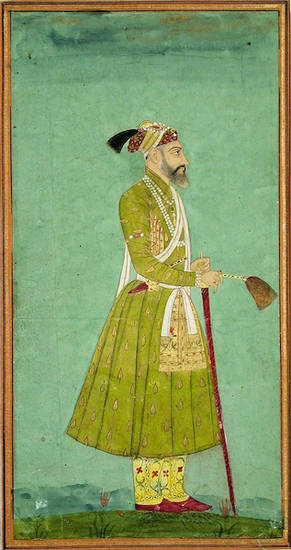
Emperor Aurangzeb
Image by Edwin Binney 3rd Collection SDMA © CC BY-NC-ND 2.0
While Jain religious leaders fell out of imperial esteem under Emperor Jahangir, other types of interactions continued throughout the 17th century. Commerce remained a profitable arena for members of both faiths. Although the close links between individual Jains and the emperor were not revived under Jahangir’s successors, Jain writers continued to view the Mughals positively.
Trade connections flourished and so did political favours associated with business relationships. For instance, Shantidas Jhaveri sold jewels to members of the Mughal elite and obtained many farmāns that advanced his commercial and personal interests.
Occasionally, Jain merchants and political figures were forced to give money to Mughal activities. For example, Shantidas Jhaveri and Virji Vora financed the unsuccessful attempt of the governor of Gujarat, Murad Bakhsh, to seize the imperial throne from Shah Jahan in 1657.
A few Jain ascetics visited Aurangzeb’s court and received farmāns benefiting their communities. But they do not appear to have cultivated ongoing relationships.
Nevertheless, Jains wrote favourably about the Mughals, including Aurangzeb, in Sanskrit and vernacular languages throughout the 17th century. Several inscriptions at Shatrunjaya also describe the Mughals in complimentary terms. Jain artworks produced in Gujarat incorporated elements of Mughal painting styles during this period.
Digambaras during Mughal rule
Digambaras do not appear to have interacted directly with the imperial court, but they nonetheless wrote about the Mughals. Digambara ascetic practices were also impacted at times by Mughal sensibilities.
In the late 16th to 17th centuries, there was a substantial Digambara community in Agra, including dozens of temples and two bhaṭṭāraka seats. But the Akbar-nāmah, Akbar’s official court history, claims that Digambara Jains were unknown at the Mughal court. There is also no evidence that any Digambaras met later Mughal emperors.
Even without direct relations, Digambara authors show a high awareness of the Mughals in their literature. For example, Rāyamalla describes the Agra bazaar and praises the Mughals in his late 16th-century Jambū-svāmi-carita – Acts of Jambū-svāmi. Writing in Hindi, Banārasīdās narrates how he was displaced as a child by Humayun’s army. He credits Akbar’s death in 1605 with largely prompting his devotion to a form of Digambara Jainism.
Digambaras also reflected on the effects of Islamicate rule more broadly during this period. For instance, written explanations of the bhaṭṭāraka institution began to emerge in the 16th century that justified mendicants donning robes under pressure from Islamic rulers. Full-fledged Digambara monks traditionally go naked, while bhaṭṭārakas wear clothing. Bhaṭṭārakas are known from at least the 14th century onwards, but the idea arises in the 16th century that this institution was developed largely in response to Islamic disapproval of public nudity.
Reading
- ‘Imperial Mughal Tolerance of Jainism and Jain Painting Activity in Gujarat’
Shridhar Andhare - Arts of Mughal India: Studies in Honour of Robert Skelton
edited by Rosemary Crill, Susan Stronge and Andrew Topsfield
Victoria and Albert Museum and Mapin Publishing; London, UK and Ahmedabad, Gujarat, India ; 2004
- ‘The Empire of Polysemy as evidenced in Artharatnavali of Samaya sundaragani’
Prabhakar Apte - Kośa vijñāna: siddhānta evaṃ mūlyāṅkana
edited by S. K. Rohra and D. Pitambar
Kendriya Hindi Samsthan; Agra, Uttar Pradesh; 1989
- Religion and Politics in India During the Seventeenth Century
Mohammad Akram Lari Azad - Criterion Publications; Delhi, India; 1990
- ‘Alamgir’s Tolerance in the Light of Contemporary Jain Literature’
Jnan Chandra - Journal of the Pakistan Historical Society
volume 6: 1
1958
- ‘Imperial Mughal Farmans in Gujarat: being farmans mainly issued in favour of Shantidas Jawahari of Ahmadabad by the Mughal emperors’
M. S. Commissariat - Journal of the University of Bombay
volume 9: 1
1940
- ‘A Tale of Two Cities: On the Origins of Digambar Sectarianism in North India’
John E. Cort - Multiple Histories: Culture and Society in the Study of Rajasthan
edited by Lawrence A. Babb, Varsha Joshi and Michael W. Meister
Rawat Publications; Jaipur, Rajasthan, India; 2002
- Bhānucandragaṇicarita
Mohanlal Dalichand Desai - Siṅghī Jaina granthamālā series; volume 15
Sanchalaka-Singhi Jain Granthamala; Ahmedabad, Gujarat, and Calcutta, Bengal, in India; 1941
- ‘Jain Perceptions of Islam in the Early Modern Period’
Paul Dundas - Indo-Iranian Journal
volume 42: 1
1999
- The Jains
Paul Dundas - Library of Religious Beliefs and Practices series; series editor John Hinnels and Ninian Smart; volume 14
Routledge Curzon Press; London, UK; 2002
- History, Scripture and Controversy in a Medieval Jain Sect
Paul Dundas - Routledge Advances in Jaina Studies series; series editor Peter Flügel; volume 2
Routledge Curzon Press; London, UK; 2007
- ‘Jāhangīr’s Vow of Non-Violence’
Ellison B. Findly - Journal of the American Oriental Society
volume 107: 2
1987
- ‘Worshipping the Ideal King: On the Social Implications of Jaina Conversion Stories’
Peter Flügel - Geschichten und Geschichte: Historiographie und Hagiographie in der asiatischen Religionsgeschichte
edited by Peter Schalk with Max Deeg, Oliver Freiberger, Christoph Kleine and Astrid van Nahl
Historia Religionum series; volume 30
Uppsala University; Uppsala, Sweden; 2010
- ‘The Jain Community and Akbar’
Surendra Gopal - Akbar and His Age
edited by Iqtidar Alam Khan
Monograph series; volume 5
Northern Book Centre; New Delhi, India; 1999
- ‘Akbar as Reflected in the Contemporary Jain Literature in Gujarat’
Shirin Mehta - Akbar and His Age
edited by Iqtidar Alam Khan
Monograph series; volume 5
Northern Book Centre; New Delhi, India; 1999
- ‘Akbar and the Jains’
Pushpa Prasad - Akbar and His India
edited by Irfan Habib
Oxford University Press; Delhi, India; 1997
- ‘The three earliest Jain Influencers of Mughal Religious Policy: Padmasundara, Ānandarāja, and Ajayarāja’
Dasharatha Sharma - Annals of the Bhandarkar Oriental Research Institute
volume 25
Bhandarkar Oriental Research Institute; Pune, Maharashtra, India; 1944
- ‘The Jain Teachers of Akbar’
Vincent A. Smith - Commemorative essays presented to Sir Ramkrishna Gopal Bhandarkar
Bhandarkar Oriental Research Institute; Poona, Maharashtra, India; 1917
- Studies in Jaina Sanskrit literature
Satya Vrat - Eastern Book Linkers; Delhi, India; 1994
- Glimpses of Jaina Sanskrit Mahākāvyas
Satya Vrat - Raj Publishing House; Jaipur, Rajasthan, India; 2003
Links
- Babur sees Jain images at Gwalior
-
In this extract from a translation of his memoirs, the Mughal Emperor Babur describes seeing the huge statues of Jinas carved into the rock at Gwalior, Madhya Pradesh.
Google Books provides selections from Babur Namur: Journal of Emperor Babur, published by Penguin in 2006.
This English translation by Dilip Hiro is based on Annette Beveridge’s 1921 translation. A fresh translation by Wheeler Thackston was published in 2002 by the Modern Library.
http://books.google.co.uk/books?id=VW2HJL689wgC&lpg=PP1&pg=PA313#v=onepage&q&f=false
- Jina statues at Gwalior
-
Flickr provides pictures of the mutilated Digambara figures of Jinas in Gwalior, Madhya Pradesh. Taken in 2007, these photographs by Sergio Conti also show some of the later repairs to several of the rock-cut statues. The huge naked images were carved in the 15th century and damaged a century later on the orders of the Emperor Babur, founder of the Mughal dynasty.
http://www.flickr.com/photos/sergioconti/2285506718/in/set-72157603874876112/
- Jain ascetic
-
The Cleveland Museum of Art provides an unusual painting of a Jain monk carrying his mendicant equipment. Clad in white robes, the monk holds his alms bowl and a staff, which mark him out as a member of a Śvetāmbara Mūrti-pūjaka sect. Under his arm he carries his monastic broom and what may be a holy text. The Gujarati artist, Basawan, who worked for the Mughal Emperor Akbar, painted this picture around 1600, and its realistic treatment shows familiarity with European artistic styles.
- Jains in the Multicultural Mughal Empire
-
Download issue 7 of the CoJS newsletter, published in March 2012, to read the article 'Jains in the Multicultural Mughal Empire' by Audrey Truschke.
The Centre of Jaina Studies in the School of Oriental and African Studies (SOAS), at the University of London, publishes an annual newsletter, which is available to download as a PDF. The newsletter features articles, summaries of research, academic news, book reviews, reports of exhibitions, notifications and reports of conferences and symposia.
You will need to have Adobe Acrobat Reader on your computer to open PDF files.
- +
- aAbhavya
- aAbhinandana
- aAbhiṣeka
- aĀcāra
- aĀcārāṅga-sūtra
- aĀcārya
- aAchalbhrata
- aAḍhāī-dvīpa
- aAdharma
- aAdho-loka
- aAdhyayana
- aAdvaita Vedānta
- aĀgama
- aAghātīya
- aAghātīya-karman
- aAgnibhuti
- aAgra
- aĀhāra
- aAhiṃsā
- aAhimsa Day
- aAjita
- aAjīva
- aAkampit
- aĀkāśa
- aAkbar the Great
- aAkṣaya-tṛtīyā
- aAlauddin Khalji
- aAlbert Einstein
- aAllah
- aAlms
- aĀlocanā
- aAloka-ākāśa
- aAmāri
- aAmbikā or Kūṣmāṇḍinī
- aAnagāra
- aAnanta
- aAnarthadaṇḍa
- aAnaśana
- aAnekānta-vāda
- aAṅga
- aAniconism
- aAnojjā
- aAntarāla
- aAntarāya-karma
- aAṇu
- aAṇu-vrata
- aAnukampā
- aAnuprekṣā
- aAnusvāra
- aApabhraṃśa
- aAparigraha
- aAra
- aĀrambha
- aĀrambhaja
- aĀratī
- aArdhamāgadhī Prākrit
- aArhaṃ
- aArhat
- aArśana-āvaraṇīya-karma
- aĀrta-dhyāna
- aĀryikā
- aĀryikā Jñānamati
- aĀśātanā
- aĀścarya
- aAscetic
- aAsceticism
- aAshram
- aAspiration
- aĀsrava
- aAṣṭa-maṅgala
- aAṣṭāpada
- aAstikāya
- aAstrolabe
- aAsura
- aAtheism
- aAticāra
- aAtiśayakṣetra
- aAtithisaṃvibhāgavrata
- aĀtma-vāda
- aĀtman
- aAuṃ
- aAurangzeb
- aAuspicious
- aAusterity
- aAvadhāna
- aAvadhi-jñāna
- aĀvaraṇī-yakarman
- aAvasarpiṇī
- aAvatāra
- aAvidyā
- aAxiom
- aĀyāga-paṭa
- aĀyambil
- aĀyu-karma
- aĀyurveda
- bBabur
- bBāhubali
- bBaladeva
- bBālāvabodha
- bBandha
- bBasadi
- bBazaar
- bBhadrankarvijay
- bBhagavant
- bBhaktāmara-stotra
- bBhakti
- bBhale
- bBharata
- bBhāṣā
- bBhāṣya
- bBhaṭṭāraka
- bBhāva
- bBhāva-pūjā
- bBhāvanā
- bBhavana-vāsin
- bBhavya
- bBhavyatva
- bBhaya
- bBhoga-bhūmi
- bBhogopabhoga
- bBodhi
- bBollywood
- bBrahmā
- bBrahma-deva
- bBrahmacārī
- bBrāhmaṇa
- bBraj Bhāṣā
- bBright fortnight
- bBritish Raj
- bBuddha
- bBuddhi-sagar
- bBuddhism
- bBuddhist
- cCaitya
- cCaityavāsin
- cCakravartin
- cCakreśvarī
- cCāmara
- cCandanā
- cCandragupta
- cCandraprabha
- cCanon
- cCāritra
- cCāritramohanīya-karman
- cCarũrī
- cCaste
- cCaturvidha-saṅgha
- cCaturviṃśati-stava
- cCāturyāma
- cCE
- cCelibacy
- cCha
- cChadmastha
- cChastity
- cCheda-sūtra
- cChristian
- cChristianity
- cClergy
- cCloning
- cColophon
- cCommentary
- cConch
- cConfession
- cCongregation
- cConsecration
- cCosmology
- cCremation
- cCrore
- cCult
- cCūrṇi
- dDādā-guru
- dDalit
- dDāna
- dDaṇḍa
- dDark fortnight
- dDarśana
- dDarśanamohanī-yakarman
- dDaśa-lakṣaṇa-parvan
- dDeity
- dDelhi Sultanate
- dDerāsar
- dDeśāvakāśika-vrata
- dDetachment
- dDevanāgarī
- dDevānandā
- dDevarddhi-gani
- dDevotee
- dDhamal
- dDhanuṣ
- dDhāra
- dDharma
- dDharma-dhyāna
- dDharma-sāgara
- dDharmastikaya
- dDhātakīkhaṇḍa
- dDholak
- dDhyāna
- dDiaspora
- dDig-vrata
- dDigambara
- dDīkṣā
- dDisciple
- dDīvālī
- dDivya-dhvani
- dDNA
- dDoctrine
- dDogma
- dDonor
- dDoṣa
- dDravya
- dDravya-pūjā
- dDrone
- dDuṣamā
- dDuṣamā-duṣamā
- dDuṣamā-suṣamā
- dDveṣa
- dDvīpa
- eEast India Company
- eEightfold Path
- eEkānta-vāda
- eEkendriya
- eElder
- eElders
- eEschatology
- eEtc up to
- fFarmān
- fFast
- fFatehpur Sikri
- fFestival
- fFestschrift
- fFiruz Shah
- fFly-Whisks
- fFolio
- fFour Noble Truths
- gGaccha
- gGaṇa
- gGaṇadhara
- gGanadharavada
- gGaṇeśa
- gGaṇin
- gGarba
- gGarbha
- gGarbha-gṛha
- gGaruḍa
- gGati
- gGene
- gGenomics
- gGhātī-yakarman
- gGhātīya
- gGhaznavid
- gGhiyasuddin Tughlaq
- gGhurid
- gGloss
- gGotra-karma
- gGujarāt
- gGujarati
- gGuṇa
- gGuṇa-sthāna
- gGuṇa-vrata
- gGupti
- gGuru
- gGuruṇī
- hHagiography
- hHajj
- hHaṃsa
- hHaribhadra
- hHariṇaigameṣin
- hHasta
- hHeresy
- hHiṃsā
- hHindi
- hHindu
- hHinduism
- hHīravijaya
- hHoroscope
- hHrīṃ
- hHumayun
- hHymn
- iIconoclasm
- iIconography
- iIdol
- iIndian Independence
- iIndology
- iIndra
- iIndrabhūti Gautama
- iIndriya
- iInitiation
- iIntercession
- iInvocation
- iIQ
- iIslam
- iIslamicate
- iIṣṭadevatā
- iĪśvara
- jJagat
- jJahangir
- jJain
- jJaina Devanāgarī
- jJaina Śaurasenī
- jJaina-dharma
- jJainaśāsana
- jJainness
- jJaisalmer
- jJamāli
- jJambū-dvīpa
- jJames Burgess
- jJanma
- jJanma-kalyāṇa
- jJarā
- jJāti
- jJina
- jJina-āgama
- jJina-bhavana
- jJina-bimba
- jJina-mātā
- jJinacandra-sūri
- jJinadatta
- jJinaprabha
- jJīva
- jJñāna
- jJñāna-āvaraṇīya-karma
- jJñāna-āvarṇiya
- jJñānsundar
- jJyotiṣka
- kKāla
- kKālakācārya-kathā
- kKālidāsa
- kKalpa-sūtra
- kKalpa-vṛkṣa
- kKalyāṇaka
- kKalyanvijay
- kKamaṇḍalu
- kKamaṭha
- kKarma
- kKarma-bhūmi
- kKarma-grantha
- kKarma-prakṛti
- kKarma-vāda
- kKarmon
- kKarnataka
- kKaṣāya
- kKathā
- kKāvya
- kKāya
- kKāyotsarga
- kKeśa-loca
- kKetu
- kKevala-jñāna
- kKevalin
- kKhalji
- kKharatara-gaccha
- kKnowledge
- kKriyā
- kKriyā-vāda
- kKṛṣṇa
- kKṣamā-śramaṇa
- kKṣapakaśreṇi
- kKṣatriya
- kKṣullaka
- kKulakara
- kKundakunda
- kKunthu
- lLabdhi
- lLaity
- lLakh
- lLāñchana
- lLands of Action
- lLaukāntika
- lLavaṇa-samudra
- lLeśyā
- lLiṅga
- lLinguistics
- lLoka
- lLoka-ākāśa
- lLoka-puruṣa
- lLoka-vāda
- lLotus
- lLotus lake
- mMadhya-loka
- mMahā-videha
- mMahā-vrata
- mMahābhārata
- mMahāmastakābhiṣeka
- mMāhārāṣṭra
- mMāhārāṣṭrī Prākrit
- mMahattarā Yākinī
- mMahāvīr Jayantī
- mMahāvīra
- mMakāra
- mMakkhali Gośāla
- mMalli
- mMāna-stambha
- mManaḥ-paryāya-jñāna
- mMaṇḍala
- mMaṇḍapa
- mMandit
- mMaṅgala
- mMantra
- mMantras
- mManuṣya-loka
- mMarāṭhī
- mMārgaṇā
- mMartyr
- mMarudevī
- mMaṭha
- mMati-jñāna
- mMauryaputra
- mMecca
- mMendicant lineage
- mMetarya
- mMiracle
- mMithyādṛṣṭi
- mMohandas Gandhi
- mMohanīya-karma
- mMokṣa
- mMonastic order
- mMonasticism
- mMonk
- mMonotheism
- mMosque
- mMount Meru
- mMount Sammeta
- mMṛgāvatī
- mMughal
- mMuhammad
- mMuhammad bin Tughlaq
- mMuhpattī
- mMūla-sūtra
- mMūlaguṇa
- mMumbaī
- mMuni
- mMunisuvrata
- mMurad Bakhsh
- mMūrti-pūjaka
- mMuslim
- mMysticism
- nNābhi
- nNāga-kal
- nNāgapurīya Tapā-gaccha
- nNāgarī
- nNāma-karma
- nNamaskāra-mantra
- nNami
- nNandīśvara-dvīpa
- nNandivardhana
- nNandyāvarta
- nNāraka
- nNāraki
- nNasalisation
- nNātha
- nNavrātrī
- nNaya-vāda
- nNemi
- nNidāna
- nniggaṃthāṇa vā 2
- nniggaṃtho vā 2
- nNigoda
- nNihnava
- nNikṣepa
- nNirgrantha
- nNirjarā
- nNirvāṇa
- nNiryukti
- nNiṣidhi
- nNitya
- nNiyati
- nNo-kaṣāya
- nNudity
- nNun
- oOcean of milk
- oOmniscience
- oOrdination
- ppa°
- pPadmaprabha
- pPadmāsana
- pPadmāvatī
- pPādukā
- pPalanquin
- pPalette
- pPañca-muṣṭi
- pPāṇḍava
- pPaṇḍit
- pPandit Dalsukh D. Malvania
- pPandit Sukhlalji
- pPāṇipātra
- pPāpa
- pParamātman
- pParameṣṭhin
- pPāraṇā
- pParigraha
- pPariṇāma
- pParīṣaha
- pParokṣa
- pPārśva
- pPārśvanātha
- pParyāya
- pParyuṣaṇ
- pPaṭa
- pPatan
- pPātra
- pPenance
- pPersian
- pPhala
- pPhilology
- pPicchikā
- pPilgrimage
- pPīr
- pPolymath
- pPoṣadha
- pPossession
- pPothī
- pPrabhas
- pPradakṣiṇā
- pPradeśa
- pPrākāra
- pPrakīrṇaka-sūtra
- pPrākrit
- pPramāda
- pPramukhā
- pPrati-vāsudeva
- pPratikramaṇa
- pPratimā
- pPratiṣṭhā
- pPratyākhyāna
- pPratyakṣa
- pPravacana
- pPrāyaścitta
- pPrayer
- pPre-modern
- pPreach
- pPredestination
- pProtestant
- pProvenance
- pPudgala
- pPūjā
- pPujārī
- pPukharavara-dvīpa
- pPuṇya
- pPūrva
- pPuṣkara-dvīpa
- pPuṣpadanta
- pPyre
- qQur’an
- rRāga
- rRāhu
- rRainy season
- rRajasthan
- rRajasthani
- rRājimatī
- rRajoharaṇa
- rRajput
- rRāma
- rRāmāyaṇa
- rRangoli
- rRās-garbā
- rRasa
- rRathanemi
- rRatna-traya
- rRātri-bhojana
- rRaudra-dhyāna
- rRecto
- rRelic
- rRenunciation
- rRetroflex
- rRevatī
- %Ṛg-veda
- rRite
- rRosary
- %Ṛṣabha
- %Ṛṣabhanātha
- rRupee
- sSaciyā Mātā
- sSādhu
- sSādhvī
- sSāgāra
- sSaint
- sŚaivaism
- sŚaka-saṃvat
- sSallekhanā
- sŚalya
- sSamacatuṣṭha
- sSamādhimaraṇa
- sSamaṇi
- sSāmarambha
- sSamavasaraṇa
- sSāmāyika
- sSaṃbhava
- sSamiti
- sSaṃjñā
- sSaṃkalpaja
- sSaṃsāra
- sSamudghāta
- sSaṃvara
- sSaṃvega
- sSamyak-cāritra
- sSamyak-darśana
- sSamyak-jñāna
- sSamyaktva
- sSaṃyama
- sSanctuary
- sSandalwood
- sSaṇgha
- sSanskrit
- sSant
- sŚānti
- sSapta-bhaṅgi-naya
- sSārambha
- sSarasvatī
- sSarvajña
- sSāsan-devi
- sŚāsana-devatā
- sŚāstra
- %Ṣaṭ-jīvanikāya
- sSatī
- sSatīmātā
- sSatya
- sSchism
- sScribe
- sScripture
- sSect
- sSecularism
- sŚenāī
- sSermon
- sŚeṣavatī
- sSevā
- sSeven fields of donation
- sShah Jahan
- sShantidas Jhaveri
- sShrine
- sSiddha
- sSiddha-śilā
- sSiddhacakra or Navadevatā
- sSiddhānta
- sSiddhārtha
- sSiddhi
- sSikh
- sSikhism
- sŚikṣā-vrata
- sŚīla
- sSin
- sSindh
- sŚītala
- sŚiva
- sSkandha
- sSomanatha
- sŚraddhā
- sŚramaṇa
- sŚrāvaka
- sŚrāvakācāra
- sŚrāvikā
- sŚreyāṃsa
- sŚrī
- sŚrīvatsa
- sŚruta-jñāna
- sŚruta-pañcamī
- sSthānaka-vāsin
- sSthāpanācārya
- sSthāvara
- sSthavira
- sSthiti
- sStrīmukti
- sStūpa
- sSubcontinent
- sSudarshana
- sŚuddhi
- sSudharma
- sŚūdra
- sSufism
- sSukha
- sŚukla-dhyāna
- sSulasā
- sSultan
- sSumati
- sSundarśrī
- sSupārśva
- sSūri
- sSuṣamā
- sSuṣamā-duṣamā
- sSuṣamā-suṣamā
- sSūtra
- sSuyam me ausam! Tenam bhagavaya evamakkhayam
- sSvādhyāya
- sSvāhā
- sSvastika
- sŚvetāmbara
- sŚvetāmbara Terāpanthin
- sŚvetāmbaras
- sSwan
- sSyād-vāda
- tTabla
- tTantra
- tTapā-gaccha
- tTapas
- tTāraṇ Svāmī Panth
- tTattva
- tTattvārtha-sūtra
- tTemple
- tTemple-city
- tThe Enlightenment
- tTheology
- tThree worlds
- %Ṭīkā
- tTilaka
- tTīrtha
- tTīrthaṃkaranāma-karman
- tTīrthankara
- tTransliteration
- tTrasa
- tTrasa-nāḍī
- tTriśalā
- tTriṣaṣṭi-śalākā-puruṣa-caritra
- tTti bemi
- tTughlaq
- tTunk
- uUdumbara
- uUniversal History
- uUpādhyāya
- uUpāṅga
- uUpaniṣads
- uUpāsaka
- uUpasarga
- uUpāśraya
- uŪrdhva-loka
- uUtsarpiṇī
- uUttarādhyayana-sūtra
- vVāhana
- vVaimānika
- vVairāgya
- vVaiṣṇava
- vVaiśramaṇa
- vVaiśya
- vValabhī
- vVanaspatikāya
- vVandana
- vVaṇik
- vVarṇa
- vVāsudeva
- vVāsupūjya
- vVayubhūti
- vVeda
- vVedanīya-karma
- vVegetarianism
- vVehicle
- vVernacular
- vVerso
- vVidyā
- vVidyā-devī
- vVihāra
- vVijñapti-patra
- vVikrama-saṃvat
- vVikṛti
- vVimala
- vVinaya
- vVipāka
- vVirji Vora
- vVirodhaja
- vVīrya
- vVisarga
- vViṣṇu
- vVītarāga
- vVizier
- vVotive
- vVow
- vVrata
- vVS
- vVyakta
- vVyantara
- vVyasana
- yYakṣa
- yYakṣī
- yYantra
- yYaśoda
- yYaśovijaya
- yYati
- yYātrā
- yYoga
- yYoginī
- yYojana


